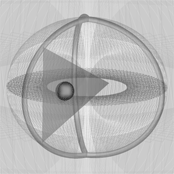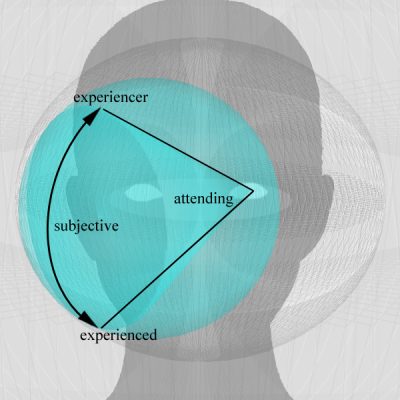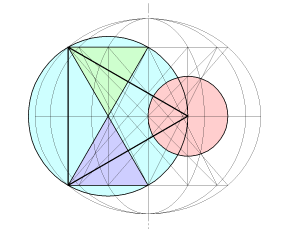




































representational inquiry regarding meaning » intelligibility » subjectivity
The M-node symbol combines a cone opening left (subjective) with a sphere (attending) and the color cyan (representing that toward which the subjective mode of attending is stretching—namely, the acquaintance knowledge accompanying qualitative experience).
 The symbol involves the conjunction of three elements (pictured to the left): a fluid/dynamic point of view (the green cone pointing down), an expansive/receptive mode of attending (the red sphere), and one's own qualitative states as the object of attention (the blue cone pointing up). When the distance between the fluid point of view (green cone) and one's own qualitative states (blue cone) is reduced to zero—the immediacy of an identity—acquaintance knowledge occurs. This identity is achieved to the same degree that the mode of attention is broad in its openness/receptivity.
The symbol involves the conjunction of three elements (pictured to the left): a fluid/dynamic point of view (the green cone pointing down), an expansive/receptive mode of attending (the red sphere), and one's own qualitative states as the object of attention (the blue cone pointing up). When the distance between the fluid point of view (green cone) and one's own qualitative states (blue cone) is reduced to zero—the immediacy of an identity—acquaintance knowledge occurs. This identity is achieved to the same degree that the mode of attention is broad in its openness/receptivity.
Insofar as qualitative experience occurs immediately—that is, unmediated by beliefs or conceptual distance—the distance between experiencer and experienced tends to shrink toward an identity. Since, diagrammatically, experiencer and experienced fall along the circumference of the subjectivity cone's base, separated by the base's diameter, the cone's base tends to collapse toward becoming a flattened line segment. When it does this, the cone becomes a triangle separating the experiencer/experienced identity, represented by one side of the triangle, from experiencing (in this case, the holistic mode of attending), represented by the opposite vertex. If the vertical dimension represents time/duration, we see that the subjective mode of attending tends toward the ever-flowing/fluctuating present. The cone of subjectivity tends to collapse toward the immediacy of present experience. We also see that the distance between the experiencer/experienced identity and the mode of experiencing is preserved. With reference to the torus, experiencing occurs along the torus's inner horizon (the donut hole) while the experiencer/experienced identity occurs along the torus's outer horizon (its horizontal limit) where the two horizons are at their greatest distance apart. This symbolizes the holistic nature of the attending. The experiencer/experienced identity is fully immersed in the fullness of its contextuality upon the plane of presence.
Another way to look at the M-node symbol is as follows: it combines a cone opening left with a cyan sphere, where both the cone opening left and the cyan sphere diagrammatically combine a mode of experiencing on the one hand with a relationship between experiencer and experienced on the other. In the case of the cone opening left, its apex represents the mode of experiencing (red sphere), while its base represents the relationship between experiencer (green cone) and experienced (blue cone). The colors cancel to white. In the case of the cyan sphere, it takes the shape of experiencing (sphere) and the color of the relationship between experiencer and experienced (green+blue).

Our letter M descends from the Proto-Sinaitic letter mem which depicted water. This original meaning works well to signify subjectivity. Subjectivity involves how one feels given one's position in the world, and feelings run deeper than thoughts. While feelings often (if not always) involve judgments, the judgments made are typically pre-consicous and closer to the psyche's unconsicous, and the unconscious might be thought of as a sea of meanings all mixed together. Think of the way the contents of dreams change radically without seeming out of the ordinary. In a dream, for instance, one moment you're playing tennis with your dentist and the next your dentist becomes your ex-wife and the tennis court is no longer in the park but on the roof of your old house. The meanings are all mixed up, because what's important is not the semantic content of the dream but the symbolic content. And symbolism is important for recognizing truth subjectively.
Words for mother in languages derived from Indo-European roots typically begin with the letter M, since the Indo-European root mater means mother. Related words include maternal, matrix, metro-, material, matter, and so on. One might object that associating motherhood with material, matter, subjectivity, and the unconscious mistakenly associates femininity and thereby womanhood with those features of our experience that traditionally we've been taught to overcome or otherwise dominate—by way of ideals, ideas, objectivity, and conscious reflection. One might object that to continue to identify feelings with femininity and thoughts with masculinity is to perpetuate patriarchy—that to continue to relate womanhood with the deeper, more primal reality of the unconscious is to continue to associate womanhood with animality, the animality to be transcended by reasoned conscious reflection—what is properly human—what is male. To connect M as in mother with subjectivity and P as in pater/father with objectivity is to run the risk of falling into the old patterns of encouraging patriarchal domination. But we can avoid this error by considering subjectivity in its own right rather than as a deficient mode of objectivity. Derivative of objectivity, subjectivity typically involves biases or concerns peculiar to an individual. But subjectivity in itself mainly invovles the what-it's-like-ness of an experience. For example, there's a what-it's-like to be a dog, or a human, or a human of a given race within a given culture. Now, of course there will be a what-it's-like to be me given my peculiar history, but mostly what-it's-like to be me is just like what-it's-like to be anyone like me and who shares my world. So subjectivity is mostly—by far—shared. Subjectivity mostly means empathy.
But again, unfortunately, subjectivity has heretofore been patriarchally defined. Subjectivity has been defined as a diminshed mode of objectivity, where it is the point of view of an observer that is adopted in both. But this Project aims to redefine subjectivity in a way that reclaims it from patriarchy. Subjectivity does not involve knowing as an isolated/autonomous/Cartesian-styled/egoic subject or observer. It involves expanding one's attention to encompass the context (world) by becoming immersed in it. When subjectivity is a mode of a subject/observer, it merely becomes trapped in its isolated sphere. But when subjectivity properly involves a mode of open/receptive attending (experiencing as world), to adopt this point of view means to exapand one's sense of self far beyond that of the automomous ego. The self becomes a durational process connecting a web of relations. The self becomes, not that which observes, but that which undergoes. And what is known (immediately, as if feeling the known) is the complex web of dynamics connecting one's peculiar self to the larger context through which it is moving as an embedded part thereof.
In this light, patriarchy clearly hasn't just been a problem for women; it's been a problem for all of us. To marginalize the importance of a full, deep, immersed experience of the world in favor of merely capturing propositional snapshots of the world does everyone a disservice. It constitutes an impoverishment of experience—a tendency toward groundlessness. To identify femininity as representative of deep, holistic, flexible connectivity is to celebrate femininity.
